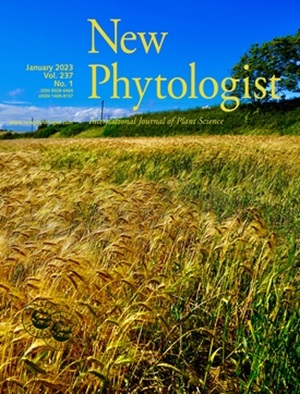Well-resolved phylogeny supports repeated evolution of keel flowers as a synergistic contributor to papilionoid legume diversification
IF 8.3
1区 生物学
Q1 PLANT SCIENCES
引用次数: 0
Abstract
- The butterfly-shaped keel flower is a highly successful floral form in angiosperms. These flowers steer the mechanical interaction with bees and thus are hypothesized to accelerate pollinator-driven diversification. The exceptionally labile evolution of keel flowers in Papilionoideae (Fabaceae) provides a suitable system to test this hypothesis.
- Using 1456 low-copy nuclear loci, we confidently resolve the early divergence history of Papilionoideae. Constrained by this backbone phylogeny, we generated a time tree for 3326 Fabales to evaluate the tempo and mode of diversification within a state-dependent evolutionary framework.
- The first keel flowers emerged c. 59.0 million years ago in Papilionoideae, predating the earliest fossil by 3–4 million years. The Miocene diversification of Papilionoideae coincided with the rapid evolution of keel flowers. At least six independent origins and 32 losses of keel flowers were identified in Papilionoideae, Cercidoideae, and Polygalaceae. However, the state-dependent diversification model was not favored.
- Lack of radiation associated with keel flowers suggests that diversification within Papilionoideae was not solely driven by pollinator-mediated selection, but instead an outcome of the synergistic effects of multiple innovations, including nitrogen fixation and chemical defense, as well as dispersal into subtropical and temperate regions.
求助全文
约1分钟内获得全文
求助全文
来源期刊

New Phytologist
生物-植物科学
自引率
5.30%
发文量
728
期刊介绍:
New Phytologist is an international electronic journal published 24 times a year. It is owned by the New Phytologist Foundation, a non-profit-making charitable organization dedicated to promoting plant science. The journal publishes excellent, novel, rigorous, and timely research and scholarship in plant science and its applications. The articles cover topics in five sections: Physiology & Development, Environment, Interaction, Evolution, and Transformative Plant Biotechnology. These sections encompass intracellular processes, global environmental change, and encourage cross-disciplinary approaches. The journal recognizes the use of techniques from molecular and cell biology, functional genomics, modeling, and system-based approaches in plant science. Abstracting and Indexing Information for New Phytologist includes Academic Search, AgBiotech News & Information, Agroforestry Abstracts, Biochemistry & Biophysics Citation Index, Botanical Pesticides, CAB Abstracts®, Environment Index, Global Health, and Plant Breeding Abstracts, and others.
 求助内容:
求助内容: 应助结果提醒方式:
应助结果提醒方式:


